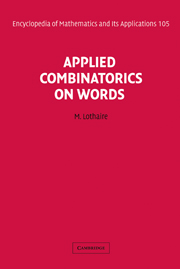Book contents
- Frontmatter
- Contents
- Preface
- Chapter 1 Algorithms on Words
- Chapter 2 Structures for Indexes
- Chapter 3 Symbolic Natural Language Processing
- Chapter 4 Statistical Natural Language Processing
- Chapter 5 Inference of Network Expressions
- Chapter 6 Statistics on Words with Applications to Biological Sequences
- Chapter 7 Analytic Approach to Pattern Matching
- Chapter 8 Periodic Structures in Words
- Chapter 9 Counting, Coding, and Sampling with Words
- Chapter 10 Words in Number Theory
- References
- General Index
Chapter 2 - Structures for Indexes
Published online by Cambridge University Press: 05 June 2013
- Frontmatter
- Contents
- Preface
- Chapter 1 Algorithms on Words
- Chapter 2 Structures for Indexes
- Chapter 3 Symbolic Natural Language Processing
- Chapter 4 Statistical Natural Language Processing
- Chapter 5 Inference of Network Expressions
- Chapter 6 Statistics on Words with Applications to Biological Sequences
- Chapter 7 Analytic Approach to Pattern Matching
- Chapter 8 Periodic Structures in Words
- Chapter 9 Counting, Coding, and Sampling with Words
- Chapter 10 Words in Number Theory
- References
- General Index
Summary
Introduction
The chapter presents data structures used to memorize the suffixes of a text and some of their applications. These structures are designed to give a fast access to all factors of the text, and this is the reason why they have a fairly large number of applications in text processing.
Two types of objects are considered in this chapter, digital trees and automata, together with their compact versions. Trees put together common prefixes of the words in the set. Automata gather in addition their common suffixes. The structures are presented in order of decreasing size.
The representation of all the suffixes of a word by an ordinary digital tree called a suffix trie (Section 2.1) has the advantage of being simple but can lead to a memory size that is quadratic in the length of the considered word. The compact tree of suffixes (Section 2.2) is guaranteed to hold in linear memory space.
The minimization (related to automata) of the suffix trie gives the minimal automaton accepting the suffixes and is described in Section 2.4. Compaction and minimization yield the compact suffix automaton of Section 2.5.
Most algorithms that build the structures presented in this chapter work in time O(n × log Card A), for a text of length n, assuming that there is an ordering on the alphabet A. Their execution time is thus linear when the alphabet is finite and fixed. Locating a word of length m in the text then takes O(m × log Card A) time.
- Type
- Chapter
- Information
- Applied Combinatorics on Words , pp. 106 - 163Publisher: Cambridge University PressPrint publication year: 2005

